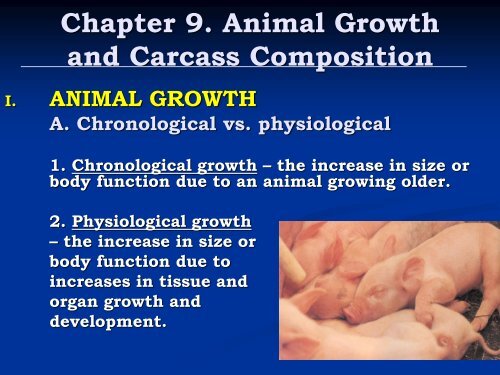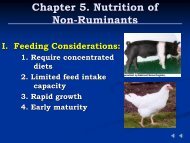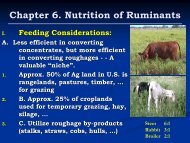and Carcass Composition
Chapter 9. Animal Growth _an_d CaroaeLComposition - Users Tamuk
Chapter 9. Animal Growth _an_d CaroaeLComposition - Users Tamuk
You also want an ePaper? Increase the reach of your titles
YUMPU automatically turns print PDFs into web optimized ePapers that Google loves.
Chapter 9. Animal Growth<br />
<strong>and</strong> <strong>Carcass</strong> <strong>Composition</strong><br />
I. ANIMAL GROWTH<br />
A. Chronological vs. physiological<br />
1. Chronological growth – the increase in size or<br />
body function due to an animal growing older.<br />
2. Physiological growth<br />
– the increase in size or<br />
body function due to<br />
increases in tissue <strong>and</strong><br />
organ growth <strong>and</strong><br />
development.
Chapter 9. Animal Growth<br />
<strong>and</strong> <strong>Carcass</strong> <strong>Composition</strong><br />
I. ANIMAL GROWTH<br />
A. Chronological vs. physiological<br />
3. Terms relating to growth:<br />
a. hypertrophy –<br />
b. hyperplasia –<br />
c. anabolism -<br />
d. catabolism -
Chapter 9. Animal Growth<br />
<strong>and</strong> <strong>Carcass</strong> <strong>Composition</strong><br />
B. Measures of Growth<br />
1. Measurements can be<br />
objective or subjective, varies by<br />
the intended use of the animal<br />
a.) meat animals<br />
-- Live weight, BCS, loin eye<br />
area, back fat thickness<br />
Body condition score
Chapter 9. Animal Growth<br />
<strong>and</strong> <strong>Carcass</strong> <strong>Composition</strong><br />
b.) breeding animals: ability to produce offspring.<br />
- - Live weight, age at first estrus, <strong>and</strong> testicle size<br />
c.) other specialty products - - milk, wool, eggs
Figure 1<br />
Scrotal circumference is measured by<br />
holding the testicles to the bottom of the<br />
scrotal sack <strong>and</strong> placing the tape around the<br />
widest point (minimum of 30 cm).<br />
Figure 2<br />
Pelvic area is measured by taking<br />
the product of vertical <strong>and</strong><br />
horizontal measurements (13 X 14<br />
cm = 175 cm 2 ).
Chapter 9. Animal Growth<br />
<strong>and</strong> <strong>Carcass</strong> <strong>Composition</strong><br />
• c.) work animals:<br />
• Body weight<br />
• Agility/Speed<br />
• Endurance<br />
• Cutting ability<br />
• Pulling power<br />
• Rate of learning
Chapter 9. Animal Growth <strong>and</strong><br />
<strong>Carcass</strong> <strong>Composition</strong><br />
2. Average Daily Gain (ADG) –<br />
measurement of growth rate.<br />
ADG =<br />
last weight – initial weight<br />
ending time – begin time<br />
- commonly used measurement of meat animals.
Chapter 9. Animal Growth <strong>and</strong><br />
<strong>Carcass</strong> <strong>Composition</strong><br />
• Other Growth Measures:<br />
For example:<br />
Body weight at<br />
52 days of age in<br />
broiler chickens/<br />
Number of days to<br />
230 lbs in swine
Chapter 9. Animal Growth<br />
<strong>and</strong> <strong>Carcass</strong> <strong>Composition</strong><br />
C. The Growth Curve<br />
1. Commonly represented as the gain in<br />
weight over time.
Chapter 9. Animal Growth<br />
<strong>and</strong> <strong>Carcass</strong> <strong>Composition</strong><br />
2. Livestock growth curve<br />
generally separated into<br />
3 phases:<br />
a.) prenatal: the increase<br />
in weight from<br />
conception to birth<br />
(i.e., zygote, embryo, &<br />
fetal phase)<br />
Factors: AOD, uterine<br />
quality, <strong>and</strong> gender of<br />
fetus<br />
What is a hinny?
Chapter 9. Animal Growth<br />
<strong>and</strong> <strong>Carcass</strong> <strong>Composition</strong><br />
Heterospermic natural matings of NZW<br />
doe to large, medium, <strong>and</strong> small breeds<br />
of buck (Flemish Giant, Californian, <strong>and</strong><br />
Florida White).
Chapter 9. Animal Growth<br />
<strong>and</strong> <strong>Carcass</strong> <strong>Composition</strong><br />
2. Livestock growth curve generally separated<br />
into 3 phases:<br />
b.) preweaning: birth to weaning<br />
- age/body size of dam<br />
- milk production<br />
- gender<br />
- no. of teats/litter size<br />
(>14 teats in swine;<br />
no > 9 kits in rabbits)<br />
“cross-fostering”
Chapter 9. Animal Growth<br />
<strong>and</strong> <strong>Carcass</strong> <strong>Composition</strong><br />
c.) postweaning: weaning to harvest<br />
- affected by preweaning<br />
background<br />
- genetics<br />
- gender<br />
- environment<br />
- nutrition
Chapter 9. Animal Growth<br />
<strong>and</strong> <strong>Carcass</strong> <strong>Composition</strong><br />
D. Factors affecting growth<br />
1. Hormonal growth<br />
a.) Hormones are chemical messengers.<br />
b.) Hormones coordinate growth <strong>and</strong><br />
development of body tissues structures,<br />
<strong>and</strong> organs – help ensure “homeostasis”<br />
Homeostasis:<br />
Is the property of a system that regulates its<br />
internal environment <strong>and</strong> tends to maintain a<br />
stable, relatively constant condition of properties<br />
such as temperature or pH (Wikipedia, 2012).
Chapter 9. Animal Growth<br />
<strong>and</strong> <strong>Carcass</strong> <strong>Composition</strong><br />
c.) Hormone secretion:<br />
endocrine gl<strong>and</strong>s<br />
circulation<br />
target tissue<br />
response
Chapter 9. Animal Growth <strong>and</strong><br />
<strong>Carcass</strong> <strong>Composition</strong><br />
d.) types of growth related hormones:<br />
1. Somatotropin (ST, “Growth Hormone”)<br />
secreted from the anterior<br />
pituitary<br />
regulates development<br />
of bone <strong>and</strong> muscle<br />
increases milk yield<br />
bST increases milk yield by<br />
repartitioning nutrients from fat<br />
to the mammary tissue
Chapter 9. Animal Growth <strong>and</strong><br />
<strong>Carcass</strong> <strong>Composition</strong><br />
pST increases meat yield by<br />
increasing protein deposition by 30%<br />
<strong>and</strong> decreases fat by 45%<br />
2. Thyroxine<br />
secreted by the thyroid gl<strong>and</strong><br />
regulates basal metabolic rate<br />
too little impairs bone <strong>and</strong><br />
muscle growth –<br />
“hypothyroidism”
Chapter 9. Animal Growth <strong>and</strong><br />
<strong>Carcass</strong> <strong>Composition</strong><br />
too much thyroxine results in<br />
less nutrient utilization due to<br />
high metabolic rate –<br />
“hyperthyroidism”<br />
exogenous hormone used to<br />
increase feathering in poultry,<br />
wool <strong>and</strong> milk production in sheep
Chapter 9. Animal Growth<br />
<strong>and</strong> <strong>Carcass</strong> <strong>Composition</strong><br />
3. Androgens<br />
the hormone,<br />
testosterone, is involved in<br />
secondary sexual<br />
development in males<br />
testosterone increases<br />
bone <strong>and</strong> muscle growth in<br />
males <strong>and</strong> females<br />
testosterone is a<br />
major <strong>and</strong>rogen that is<br />
produced in the testes <strong>and</strong><br />
in the adrenal gl<strong>and</strong>s
Chapter 9. Animal Growth <strong>and</strong><br />
<strong>Carcass</strong> <strong>Composition</strong><br />
4. Estrogens<br />
secreted from the ovaries<br />
increases muscle growth in<br />
ruminants <strong>and</strong> fat deposition in<br />
poultry<br />
slows growth of these tissue<br />
types in other species
Chapter 9. Animal Growth<br />
<strong>and</strong> <strong>Carcass</strong> <strong>Composition</strong><br />
5. Glucocorticoids<br />
secreted from the adrenal gl<strong>and</strong>s<br />
involved in stress <strong>and</strong> inflammation<br />
stimulates feeding<br />
(increase appetite)<br />
repartitions nutrients<br />
(to produce energy for growth)
Chapter 9. Animal Growth <strong>and</strong><br />
<strong>Carcass</strong> <strong>Composition</strong><br />
E. General Growth Factors:<br />
1. Genetics<br />
a.) genetic predetermination at<br />
conception of animal’s body size <strong>and</strong><br />
growth rate<br />
b.) preweaning growth largely<br />
dependent on milk availability, but<br />
postweaning growth gain is largely<br />
dependent on the animal’s genetics<br />
c.) genetic or hormonal imbalance can<br />
harm growth potential
Chapter 9. Animal Growth<br />
<strong>and</strong> <strong>Carcass</strong> <strong>Composition</strong><br />
2. Milk Production<br />
• In beef cattle, about<br />
50% of variation in<br />
weaning weights of<br />
calves is due to<br />
differences among<br />
cows in milk<br />
production.<br />
• In rabbits, it is said<br />
that the litter is “made<br />
in the nestbox”.
Chapter 9. Animal Growth<br />
<strong>and</strong> <strong>Carcass</strong> <strong>Composition</strong><br />
3. Gender<br />
a.) <strong>and</strong>rogens vs. estrogens<br />
males grow faster than females<br />
differences are<br />
larger in cattle,<br />
goats, <strong>and</strong> sheep<br />
than in swine<br />
Belgian Blue Bulls
Chapter 9. Animal Growth<br />
<strong>and</strong> <strong>Carcass</strong> <strong>Composition</strong><br />
4. Nutrition<br />
a.) diet affects immediate<br />
<strong>and</strong> subsequent growth<br />
traits<br />
too much = fat deposition<br />
= decreased bone <strong>and</strong><br />
organ growth <strong>and</strong><br />
development<br />
b.) compensatory gain
Chapter 9. Animal Growth<br />
<strong>and</strong> <strong>Carcass</strong> <strong>Composition</strong><br />
Compensatory gain<br />
a.) very rapid<br />
growth when an<br />
animal on a<br />
nutrient poor<br />
diet switched to<br />
a nutrient rich<br />
diet
Chapter 9. Animal Growth <strong>and</strong><br />
<strong>Carcass</strong> <strong>Composition</strong><br />
5. Antibiotics/Feed Additives/Implants<br />
reduce incidence of disease<br />
increase growth <strong>and</strong> nutrient<br />
efficiency<br />
alter rumen micro-organisms<br />
which may improve<br />
nutrient utilization
Chapter 9. Animal Growth<br />
<strong>and</strong> <strong>Carcass</strong> <strong>Composition</strong><br />
6. Physical environment<br />
a.) shelter, flooring, cage size,<br />
population density, sounds,<br />
<strong>and</strong> climate affect growth<br />
7. Management<br />
a.) animal care <strong>and</strong> well-being
Chapter 9. Animal Growth<br />
<strong>and</strong> <strong>Carcass</strong> <strong>Composition</strong><br />
II. <strong>Carcass</strong> <strong>Composition</strong><br />
A. 3 main constituents<br />
1. bone muscle fat<br />
a.) total amount of increase or change<br />
as growth occurs.<br />
will differ<br />
b.) proportion of each constituent<br />
Younger animals > bone & muscle<br />
than older animals > fat<br />
Real-Time Ultrasound<br />
Evaluation of <strong>Carcass</strong><br />
Traits
Chapter 9. Animal Growth <strong>and</strong><br />
<strong>Carcass</strong> <strong>Composition</strong><br />
c.) rate of tissue proportion<br />
changes depends on:<br />
species<br />
breed<br />
animal type<br />
gender<br />
diet<br />
age




